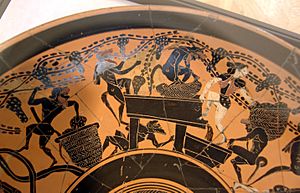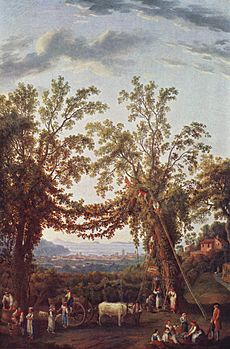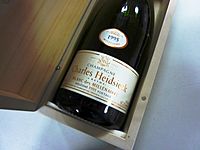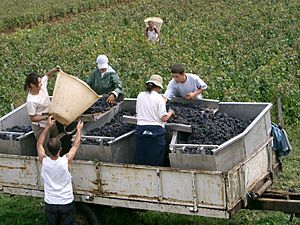Vintage facts for kids

In the world of winemaking, the word vintage means the process of picking grapes and turning them into wine. A vintage wine is special because it's made from grapes that were all, or mostly, grown and picked in a single specific year. For some wines, like Port wine, a "vintage" label means it's from one of their very best years. Because of this, people sometimes use the word "vintage" to describe any wine that seems old or really good, even if it's not technically a vintage wine.
Most countries allow a small amount of grapes from other years to be in a vintage wine. For example, in Australia and countries in the European Union, at least 85% of the grapes must be from the year shown on the label. In the United States, it's also 85%, but if the wine comes from a special growing area like Napa Valley, then 95% of the grapes must be from that year.
The opposite of a vintage wine is a nonvintage wine, often called NV. This kind of wine is usually a mix of grapes from two or more different years. Winemakers do this to make sure their wine tastes the same every year, no matter what the weather was like.
Contents
What Does 'Vintage' Mean?
The word vintage first appeared in the early 1400s. It came from an old French word, vendage, which meant "wine harvest." This word itself came from the Latin word vindemia, meaning "grape-gathering." So, the word has always been about collecting grapes!
Why Is Vintage Important?
How important a vintage is can depend on where the wine is made and what people think.
For wines made in places with colder climates, the vintage can be very important. This is because some years are much warmer, which helps the grapes get perfectly ripe and makes better wine. If the growing season is bad, the grapes might not ripen enough. This can lead to grape juice that's too sour and not sweet enough, which affects the wine's quality.
In many wine regions, especially in newer wine-producing countries, the growing seasons are much more consistent. In dry areas, using irrigation (watering the plants) in a controlled way also helps make the vintages more uniform. Even so, these wines are still often labeled with a vintage because people like to see it.
Wines from excellent vintage years, especially from famous wineries, often cost a lot more than wines from average years. This is particularly true for wines that are expected to get even better as they age in the bottle. Some wines are only given a vintage label in years when the grapes are exceptionally good, to protect their reputation. However, most wines are made to be enjoyed young and fresh. For these, the vintage is usually less important. Still, a vintage label can help you know if a wine is meant to be drunk soon, like Beaujolais nouveau, which is best enjoyed within months of being bottled.
Sometimes, the importance of vintage might be overemphasized. Some wine experts, like Frank J. Prial from The New York Times, have said that vintage charts (which rate years) are not as useful anymore. They argue that winemakers now have the technology and skills to make good wines even in years that weren't perfect for growing grapes. James Laube of Wine Spectator also agrees, saying that "even an average vintage can yield some grand wines."
Do Experts Always Agree?
A professor named Roman L. Weil from the University of Chicago did a study to see if experienced wine drinkers could really tell the difference between wines from "good" and "bad" vintage years in blind tastings. He also wanted to know if their opinions matched the vintage charts.
Weil had 240 wine drinkers taste wines that were between four and 17 years old. He found that the tasters generally couldn't tell the difference between wines from good and bad vintages, except for Bordeaux wines. Even when they could tell a difference, their choices were often no better than if they had just guessed. When the tests were repeated with wine experts, including French wine academics, the results were still mostly by chance.
Weil doesn't think vintage charts are completely useless, though. He suggests using them to find good deals. You might find great wines from years that were rated "Appalling" (very bad) because they might be priced much lower than their actual quality.
Other Facts About Vintage
- In Spain, wine regulators officially publish how good each vintage year was.
- A common saying in the Bordeaux region is: "The best vintage is the vintage we have to sell." This means that every year's wine is important to sell.
See also
 In Spanish: Añada para niños
In Spanish: Añada para niños





